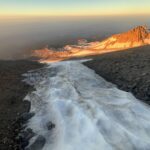As originally published in the American Avalanche Association’s quarterly publication The Avalanche Review, Volume 37.4 in April 2019.
Successive eruptions of hot ash and magma have created layer upon layer of lava-carved plains below the massive stratovolcano that is Mount Shasta.
Shasta is perched 200 miles north of the Tahoe Basin and approximately 60 miles south of the Oregon border; it is the second tallest peak in the Cascade Range and there is no other mountain like it in California. At 14,179 feet, the summit is guarded by large bands of pumice cliff and basalt gendarmes. As a result of violent winter storms, these rocks become plastered in twisted gargoyles of wind-sculpted rime ice that stand watch over the mountain like a gothic cathedral. The solitary nature of the mountain in the atmosphere creates unique orographics with high wind speeds.
With a vertical drop of more than 7000 feet off the summit in every direction and easy-to-navigate glacial terrain, Shasta offers more classic ski descent options than any other peak in the range. However, timing your ski descent off the upper mountain in ideal conditions can be tricky.
The wet season begins in October. Above 8000 feet, thick stands of mixed conifer forest give way to an exposed alpine environment where significant snow accumulation can occur. As winter begins, the rugged volcanic landscape begins to change shape under a blanket of new snow. Rock anchoring become less effective. Eventually, large planar slopes develop, creating ideal bed surfaces that circle the volcano. This transformation process, to what John Muir described as “the great white Shasta cone,” can happen during just one storm.
One tropical storm after the next, moisture-laden air is funnelled north through the narrowing Sacramento River canyon until it violently impacts the mountain’s south side. Above treeline, powerful wind creates widespread loading and deep wind slabs. Failures occur in non-persistent layers or at the old snow interface.
These slides can be highly destructive and often run for long distances. Historically large events have even stopped a ski area from operating above treeline. When it finally stops snowing, wind and temperature fluctuations mean that the consolidation process happens quickly. Rapidly consolidated new snow becomes the bed surface for the next round of storms and the process repeats itself. It’s not uncommon to find the winter snow surface above treeline overlain by sastrugi and frozen crust that can make uphill travel with climbing skins nearly impossible.
Winter ski descents from the summit are rare, but not unheard of. A complete descent in cold powder snow is even more elusive. New snow above treeline becomes wind affected quickly. Watching the forecast for warm weather is the most reliable approach to plan a descent from the upper mountain. During the winter, small warming anomalies offer a short window to ski soft snow near the icy summit before the arrival of spring. This type of weather window can arrive as little as once per month and sometimes will last just a single day. Steep and icy faces on the upper mountain will soften on south aspects as they are more directly exposed to the sun’s low position in the winter sky. Look for a day when an upper level ridge is centered over northern California with a forecasted 700 millibar temperature of at least 0ºC and no wind. Timing can be tricky but if conditions align, you’ll likely have the entire mountain to yourself.
Mount Shasta is a mecca for spring skiing. As spring rolls around, mountaineers, skiers, and guides all flock to the area. The mountain’s southern latitude means the spring weather is generally stable in comparison to the other Cascade volcanos further north. With the transition to spring in April comes the beginning of a legendary corn cycle. As the freezing level begins to rise, sunny days and mild temperatures mean the timing for a ski descent becomes more predictable.
Weather windows become more frequent and sustained. Reliable California weather between intermittent spring showers also affords the best opportunity to ski high density powder snow at upper elevations.
As April turns to May, precipitation becomes less frequent. Wide open faces and chutes abundant around the mountain begin to soften in the sun at all elevations. A strong melt-freeze cycle creates a smooth and flawless snow surface for thousands of vertical feet. Loose wet slides beome more common. Rime covered rocks on the upper mountain begin to shed their winter coat. Pellets of melting ice and loose volcanic rock rain down on the slopes below. Falling debris poses a significant hazard and is critical to anticipate with the timing of your climb. However, this risk can certainly be worth the reward. To this day, I have not yet experienced better quality spring skiing than the corn snow found high on Mount Shasta.
The perfect combination of a deep maritime snowpack and warm sunny days keep the ski season often going strong into July. As spring gives way to summer, more desirable conditions are found on the sides of the mountain less directly exposed to the sun’s increasingly high position in the sky. The window for perfect snow from top to bottom becomes smaller and more difficult to obtain as heating becomes more rapid and intense with each new day. Like skiing anywhere in the world, timing on Mount Shasta is everything. Get it right and the mountain will provide you some of the best spring conditions the Cascade volcanoes have to offer.






